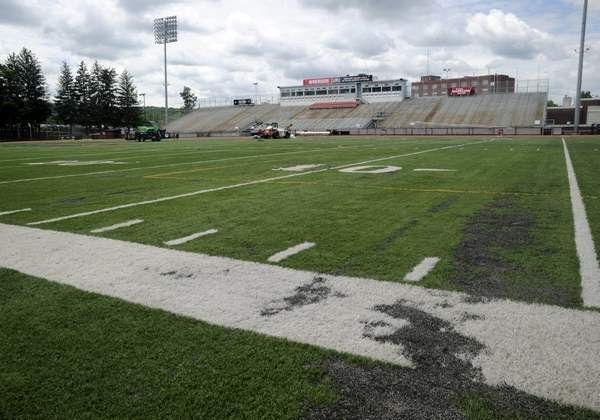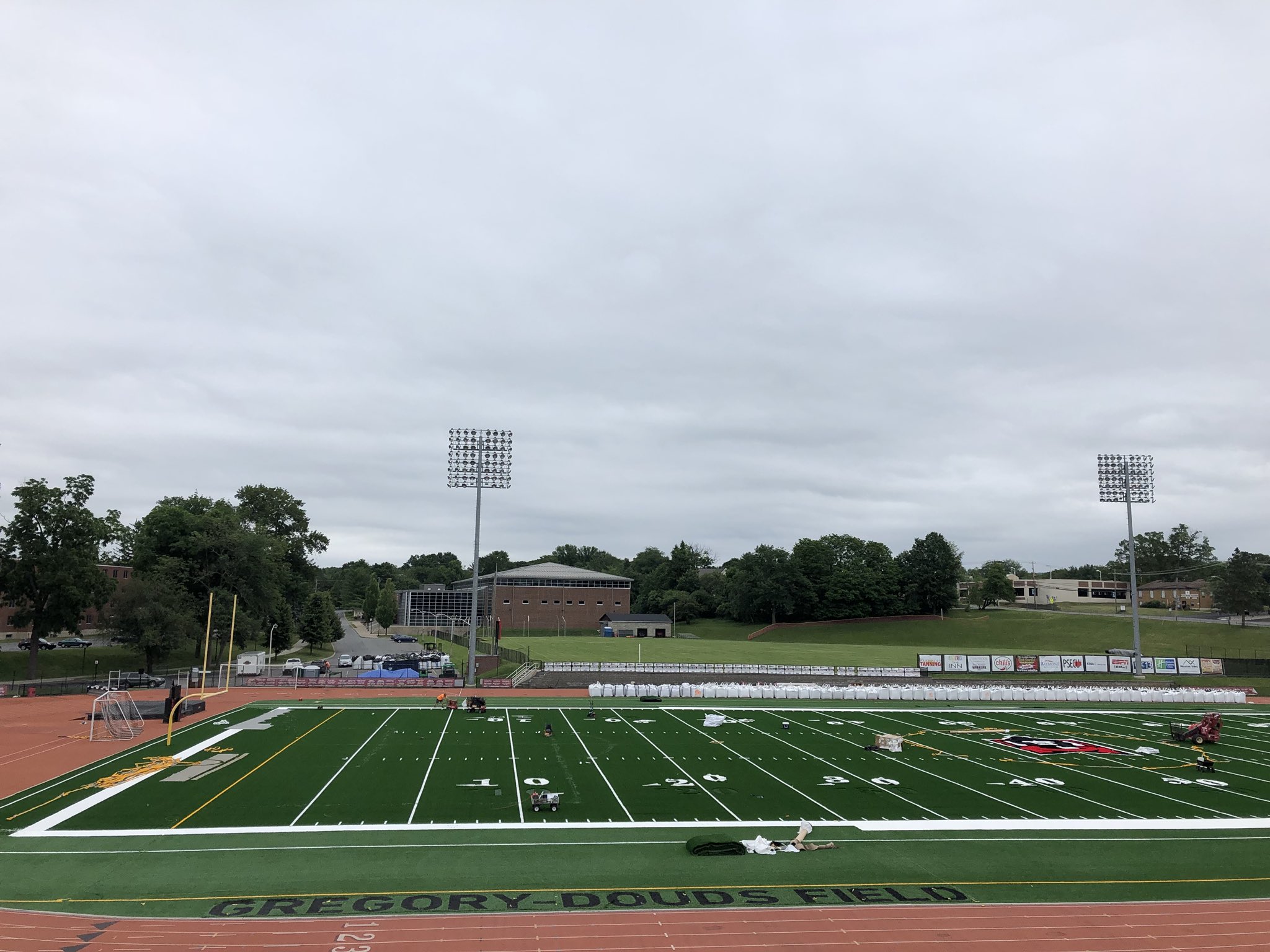
By Ryan McFadden
News Editor
ESU is revitalizing its home field advantage this year with new turf on Gregory-Douds Field, where it’s football and soccer teams play.
The university’s administration estimated that Fieldturf, an artificial field manufacturer, will finish the nearly $500,000 replacement project by the end of this month. Just in time for the first football practices of the 2018 season.
After 10 years, the continued deterioration of Gregory-Douds Field at Eiler-Martin Stadium began posing risks to player’s safety, according to Ken Long, Vice President of Administration and Finance.
“Our athletes and coaches were telling us, there’s soft spots,” said Long. “Generally, what that means to you is that some of the material is starting to break down. The useful life of that product had already reached its end.”
Fieldturf, selected in a bidding process to replace the field, became the target of several class action lawsuits roughly seven years ago, when a handful of the company’s Duraspine turf fields began showing premature wear and tear.
Joe Germani, a Fieldturf spokesperson, insists the defective Duraspine material never threatened player safety and that only the appearance of the fields began to degrade faster than advertised.
School districts from San Diego, Calif. to New Castle, Pa. joined or filed national class action lawsuits against Fieldturf, with some of them accusing the company of fraud.
“FieldTurf knew its Duraspine Turf fields were defective,” read the class action complaint filed by Hudson County, New Jersey. “For most of the time they sold the fields, which cost at least $300,000 to $500,000 each, executives were aware the turf was deteriorating faster than expected and might not last a decade or more as promised,”
Recently, the New Jersey attorney general’s office found no wrongdoing on the part of Fieldturf after completing its investigation into those allegations of fraud, according to documents presented by ESU’s administration.
Gregory-Douds field used the Duraspine material when it was installed in 2008 but according to Long, it never saw the defects that plagued other Fieldturf football and soccer fields around the nation.
“We still do our due diligence,” said Long. “Hey there’s some lawsuit with some merit out there and we looked at it and said, ‘we have this product here,’ we have it on our field hockey and lacrosse field (too). We haven’t had the failures.”

ESU followed the state procurement code to select Fieldturf for the replacement project. Which means it chose whichever state-sponsored manufacturer offered the lowest price, so long as no mitigating factors injured ESU’s trust in the company, according to the university’s administration.
One mitigating factor would include receiving defective material from the same company in the past, according to Long.
Although other schools did receive defective Duraspine material from Fieldturf, ESU was looking at its own past with the company, and Fieldturf’s relationship with NFL teams before doing business with them again, according to the university’s administration.
“New England Patriots, they use them and renewed 2006, 2010, 2014, 2016, I’ve got a feeling they’re kind of reputable,” Long said.
According to Long, ESU had been saving up money for this replacement project the same way someone might budget for a vacation; holding off on other major expenses to make room for an expenditure of greater worth.
“This is big dollars and it has to be done right,” Long said. “We plan for this. We set money aside. Two years ago, we started getting concerns about the field. So, we started setting money aside last year. We set a little bit aside this year.”
Long described student athletics at ESU as a foundation of the university and that student athlete safety is a top priority.
“Of our nearly 7,000 students, close to 3000 participate in some type of extracurricular sports activity,” Long said. “We have actually roughly half of our students participating and working and playing on those fields, safety has got to be important,” he said.
Approximately 75 to 85 percent of ESU’s spending money comes from student’s tuition and fees, according to Long.
The replacement project at Eiler Martin will cost ESU and its students $498,936.
Eiler-Martin’s new turf will feature Fieldturf’s newest product line called “Classic HD.”
Lucas Oil Stadium, home of the NFL’s Indianapolis Colts, features a “Classic HD,” turf field manufactured by Fieldturf. In 2010, Lucas Oil Stadium was voted by the NFL Players Association the number one artificial surface in the NFL, all according to Fieldturf’s website.
“We deliver high-quality products that are some of the most innovative on the market,” said Germani.
“Our fibers outperform the competition in multiple industry tests, including Pennsylvania State’s Fiber Wear Testing and Labosport’s Fiber Performance Index (FPI). We value our customers and are pleased that ESU has selected FieldTurf for their new field.”
Long estimated that the Duraspine playing surface on ESU’s Whitenight field will be replaced around this time next year. That project will likely cost another near-half million-dollar figure according to the university’s administration.
Whitenight field, where the lacrosse and field hockey teams play, is another artificial turf field installed by Fieldturf in 2008.
The Whitenight replacement project could potentially use another Fieldturf product, but only if the company can maintain its bid-winning low prices, and lack of mitigating factors from ESU’s perspective, according to Long.
Email Ryan

